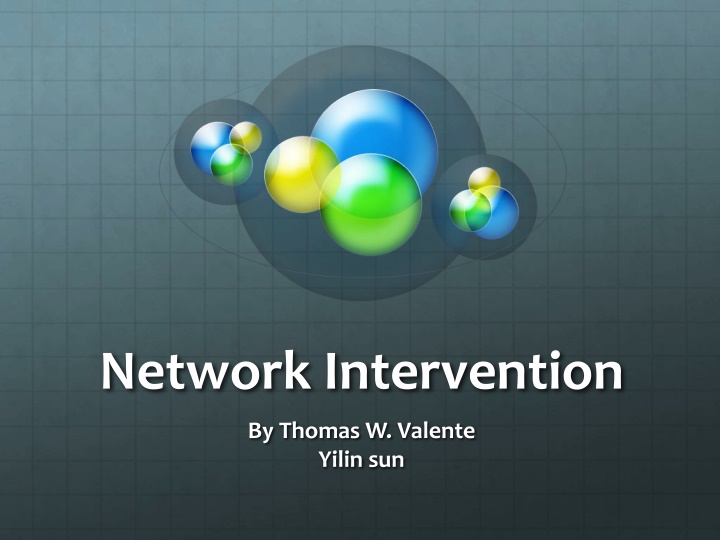
Network Intervention Strategies: Influencing Behavior Through Social Networks
Explore how network interventions leverage social networks to bring about behavior change. Learn about strategies like identifying leaders, bridging individuals, and recruiting low-threshold change agents, and understand the importance of isolating peripheral nodes for effective interventions.
Download Presentation

Please find below an Image/Link to download the presentation.
The content on the website is provided AS IS for your information and personal use only. It may not be sold, licensed, or shared on other websites without obtaining consent from the author. If you encounter any issues during the download, it is possible that the publisher has removed the file from their server.
You are allowed to download the files provided on this website for personal or commercial use, subject to the condition that they are used lawfully. All files are the property of their respective owners.
The content on the website is provided AS IS for your information and personal use only. It may not be sold, licensed, or shared on other websites without obtaining consent from the author.
E N D
Presentation Transcript
Network Intervention By Thomas W. Valente Yilin sun
Introduction The research on social networks has shown that people can be influenced by their social networks to adopt new ideas that affect their personal lives. Network interventions are purposeful efforts to use social networks or social network data to generate social influence, accelerate behavior change among individuals or communities.
Network Intervention Strategies Identifying individuals Segmentation Induction Alteration
Leader Those who received the most nominations up to some threshold, the top 10 to 15%, were identified as leaders. nodes 28, 8, 13, 37, 19, and 6 We use conception of centrality to count nominations.
Bridging Individuals More easy to change and may be in a better position to change others. Brokers (nodes 8, 28, 6, 37, 19, and 13) who have many connections to people who are not directly connected . Bridges whose connections maximally increase network cohesion (nodes 14, 37, 24, 6, and 35).
Low-threshold change agents Those people should be recruited when the researcher wants to create early momentum for the change and accelerate the time to reach a critical mass or tipping point. Low-threshold adopters are individuals willing to adopt a new idea earlier than their peers.
Isolate Nodes People on the margins of the community or organization may also be identified by change programs, because they are potentially excluded from services or the positive supports derived from community participation, not for their ability to persuade others. Peripheral individuals may be important to identify, as they are often the source of new ideas and innovations because they have contacts with other communities and/or are free from the social pressure to conform.
Induction Induction interventions stimulate or force peer-to- peer interaction to create cascades in information/behavioral diffusion. Word-of-mouth (WOM) interventions In respondent-driven sampling (RDS) Network outreach
World of Mouth Word-of-mouth (WOM) interventions stimulate interpersonal communication to persuade others to adopt the new behavior. The success of WOM is a function of the network position of initial adopters and the incentives they have to recruit others.
In Respondent-Driven Sampling (RDS) Also known as snowball methods In RDS, an initial set of people who are members of the community or population to be influenced are selected and identified as seeds. These seeds then recruit members of their social networks who subsequently encourage additional people to participate, and so on .
Network Outreach The network seeds recruit members of their personal networks to participate in an intervention together, in which the behavior change messages can be delivered to the entire group.
Alteration Adding/deleting nodes Adding/deleting links Rewiring existing links
Selecting an Intervention Selecting an appropriate network intervention depends on many factors, including the type and character of available network data, the type of behavior change being promoted, and the environmental or situational context. You have to choose the most validity and reliability data, and then choose an appropriate strategy.
Some Factors Influence Intervention Geographic distance Characteristics of the behavior Interdependent behaviors Prevalence Perceived political support or acceptability of the new behavior
Conclusion Existing evidence indicates that network interventions are quite effective. The options for network interventions have been dramatically enhanced by communication and information technologies , These electronic networks are often composed of friends (sometimes close friends), and much affective communication now occurs over electronic media. The studies reviewed here indicate that networked interventions are more effective to achieve a goal than non-network alternatives.
